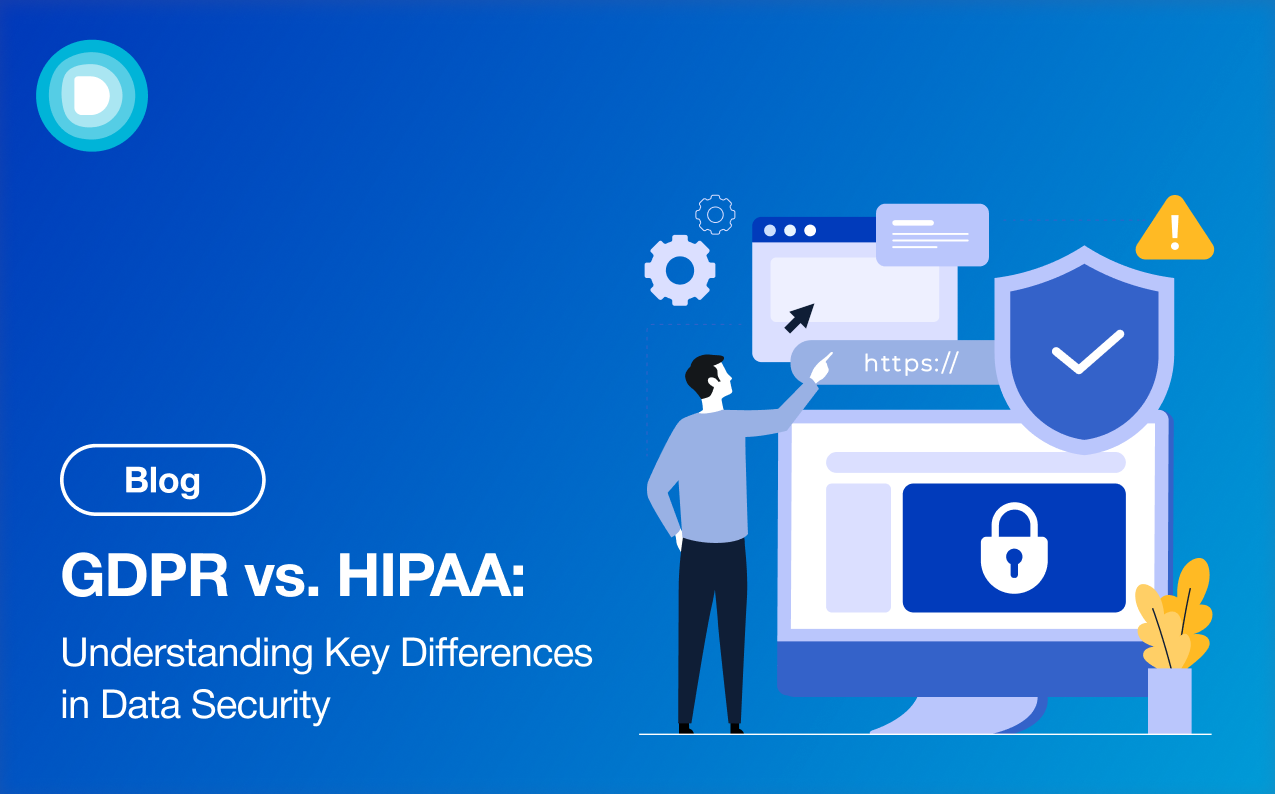- Product
-
Solution
-
By Industry
Cybersecurity solutions tailored to your industry’s needs.
-
- Resources
-
Books
Our ultimate guides and playbooks
Solution Briefs
Overview of PureDome’s functionality
-
Quizzes
Assess your cybersecurity readiness
Case Studies
PureDome customer success stories
Newsletter
Subscribe to the PureDome newsletter
-
- About Us
- Partner
- Pricing
- Download
GDPR vs. HIPAA: Understanding Key Differences in Data Security
-
Aiman Ikram
-
14 Apr 2025
- 3 min read

2.3 billion. That’s how many records were exposed in data breaches just in the first half of 2023. Some of those breaches hit healthcare providers, others hit businesses handling customer data across borders. But one thing is clear: data protection laws like GDPR and HIPAA aren’t just legal jargon.
So, what’s the difference between GDPR vs HIPAA? And why should businesses—especially those managing remote teams or handling sensitive data—pay attention? Let’s unpack it in a way that doesn’t feel like reading a legal textbook.
Why Do GDPR and HIPAA Even Exist?
Before diving into the technical stuff, let’s take a step back. Why do we have these laws in the first place? Well, it comes down to trust. Data breaches erode consumer confidence. Businesses want protection. Governments respond with regulations.
GDPR and HIPAA serve the same fundamental goal: data security. But they approach it differently.
- GDPR (General Data Protection Regulation) – The European Union’s attempt to give individuals control over their data. It applies to any business handling EU citizens’ data, even if the company isn’t based in Europe.
- HIPAA (Health Insurance Portability and Accountability Act) – A U.S. law designed to protect patients’ health information. It’s strict about how healthcare providers, insurers, and business associates handle sensitive medical data.
The intent is the same—protecting personal information—but the scope and application differ significantly.
Who Needs to Worry About GDPR vs. HIPAA?
If you handle customer data, especially across borders, you’re likely subject to one (or both) of these laws. But let’s break it down.
- If you’re in healthcare – You must comply with HIPAA. If you serve patients in Europe, GDPR may also apply.
- If you’re a tech company with global customers – GDPR is your main concern, but if you process health data, HIPAA could be relevant.
- If you run a remote team handling sensitive information – Secure access, encrypted connections, and data residency policies matter.
GDPR is broad, covering almost all businesses. HIPAA is more niche but incredibly strict.
Key Differences: GDPR vs. HIPAA
Data security regulations can get overwhelming, so let’s break them down into digestible bits.
|
Aspect |
GDPR |
HIPAA |
|
Scope & Applicability |
Covers all personal data across industries |
Focuses only on healthcare data |
|
Data Ownership & Rights |
Individuals control their data |
Healthcare providers control patient data |
|
Security Requirements |
Encryption, pseudonymization, strict access controls |
Physical, technical, and administrative safeguards |
|
Breach Notification |
Must notify authorities within 72 hours |
Must notify within 60 days (if 500+ affected) |
Why Remote Businesses Need to Care
Now, here’s where things get tricky. Most modern businesses are remote-first or have teams spread across multiple locations. That means:
- Employees access sensitive data from different regions.
- Data moves across international borders.
- Cybersecurity risks increase when teams work from anywhere.
If your team operates globally, you might have to comply with both GDPR and HIPAA simultaneously. And that’s where a strong cybersecurity infrastructure becomes non-negotiable.
How to Stay Secure Under GDPR & HIPAA
If you’re handling personal or health-related data, there are a few core principles you need to follow to stay compliant. These principles include:
- Use end-to-end encryption – Protect data whether it’s at rest or in transit.
- Limit access – Only authorized personnel should handle sensitive information.
- Implement multi-factor authentication (MFA) – Reduce the risk of unauthorized access.
- Ensure secure remote access – Remote employees should connect through encrypted, dedicated networks.
PureDome: Secure, Compliant, and Built for a Zero Trust World
Navigating GDPR and HIPAA compliance is tough. But securing your data doesn’t have to be.
That’s where Zero Trust Network Access (ZTNA) comes in. Traditional network security assumes that once inside the perimeter, users are trusted. ZTNA flips this model—every request is verified, and access is granted on a need-to-know basis.
With PureDome, businesses can:
- Enforce Zero Trust principles – No implicit trust; access is verified continuously.
- Secure remote access – Employees and contractors connect via encrypted tunnels, reducing exposure.
- Control network permissions – Assign role-based access to ensure the right people access the right data.
- Ensure compliance with GDPR & HIPAA – Keep data encrypted, access tightly restricted, and activity logged.
Learn more about ZTNA implementation here.
Whether you’re handling patient data under HIPAA or protecting customer information under GDPR, PureDome helps you build a secure, compliant infrastructure—without unnecessary complexity.
Data security isn’t just a legal requirement. It’s a business imperative. And with the right tools in place, compliance doesn’t have to be a hassle.
Final Thoughts
GDPR and HIPAA may seem like bureaucratic nightmares, but at their core, they’re about protecting people. Understanding the differences—and ensuring the right security measures—keeps your business safe, compliant, and trusted.
And in today’s digital-first world, trust is everything.